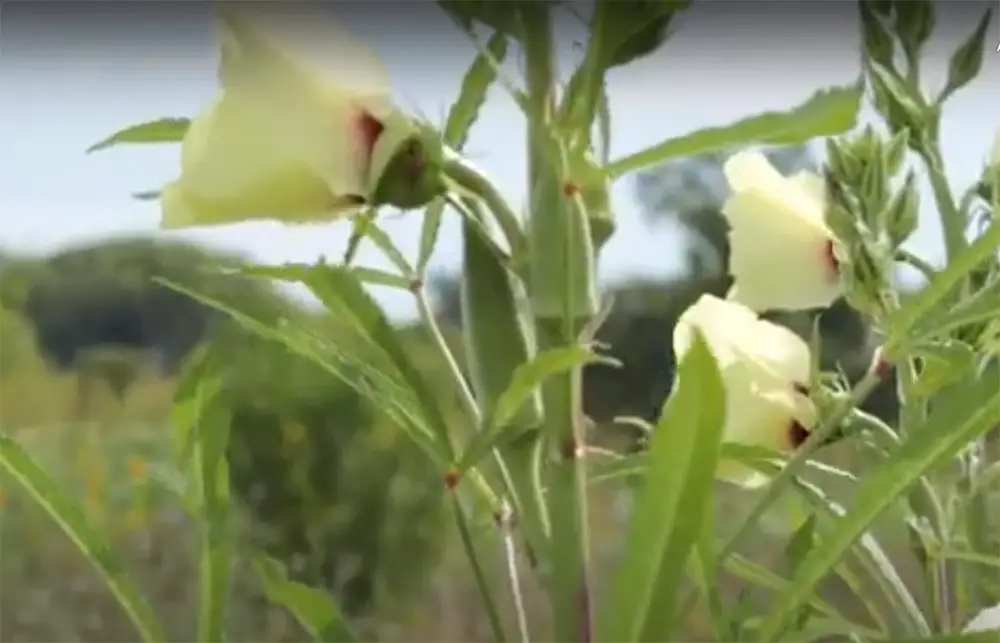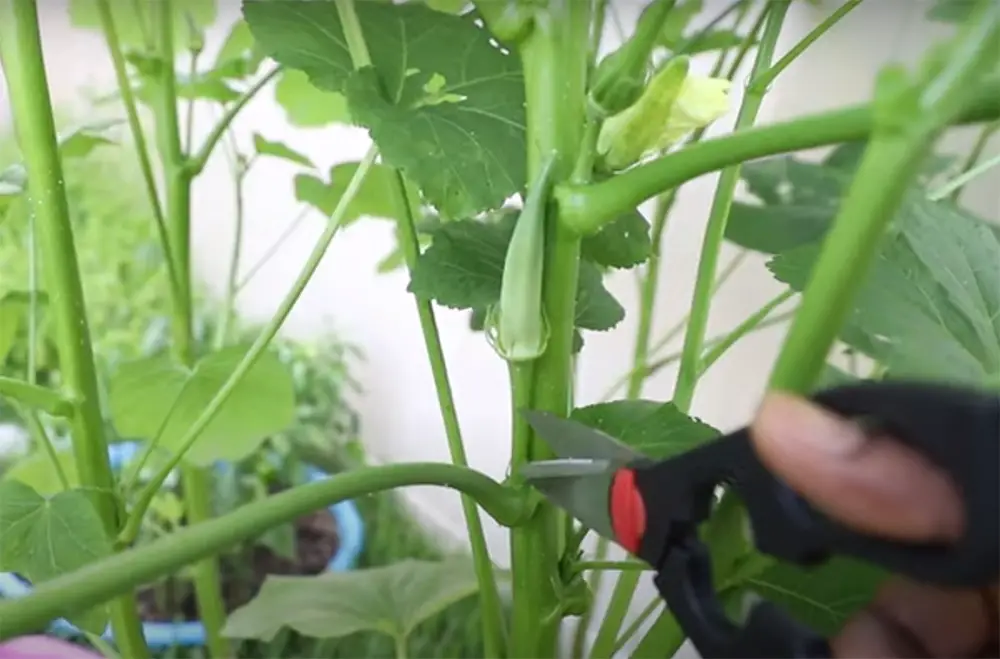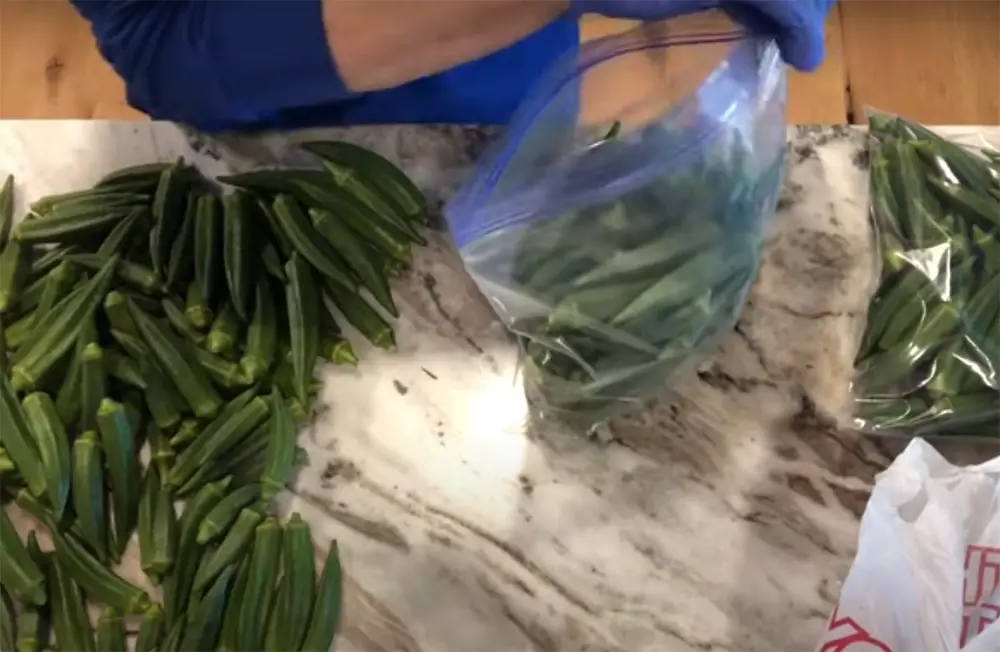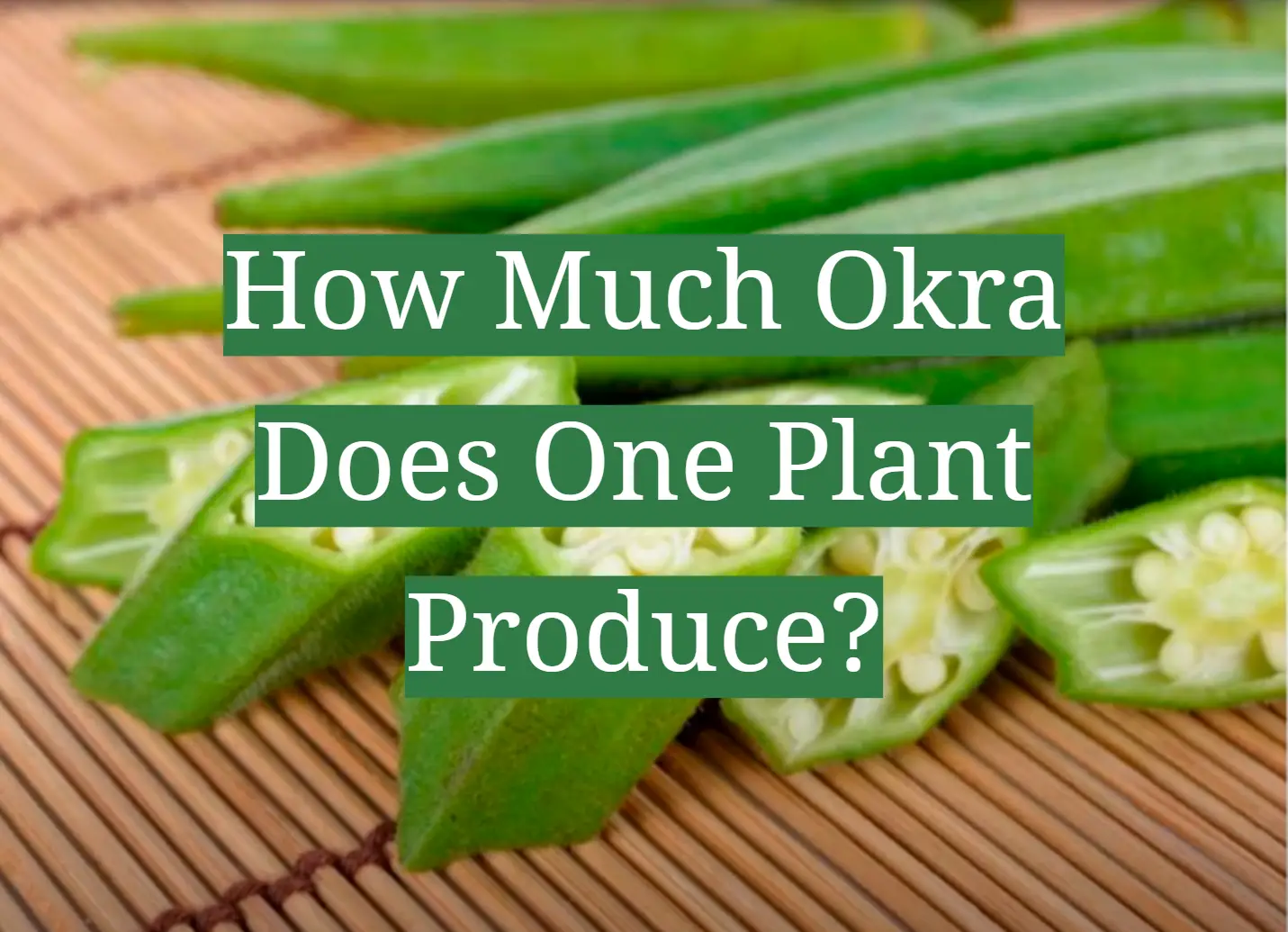Do you want to enjoy the bounty of spring harvests for years to come? Planting okra is a great way to achieve this goal! Not only is okra highly nutritious and delicious, but it is also incredibly easy to grow. The real question though, is how much does one plant of okra typically produce? You’re in luck: this blog post has all the answers about the amazing benefits of planting okra and how much you can expect from your own harvest!
What is okra?
Okra is low in calories and contains no saturated fat or cholesterol. It is a good source of dietary fiber, vitamin C, and folate. It also contains significant amounts of potassium, magnesium, and other essential nutrients.

The edible part of the okra plant is its green seed pods, which are long and tapered with ridges along its length. These pods have a slightly fuzzy texture on the outside and contain small white seeds inside.
Okra is typically harvested when the pods are still tender and immature, as this is when they are most flavorful and have a more appealing texture. Okra is widely used in cooking and can be prepared in many different ways. It is commonly used in stews, soups, curries, and stir-fried dishes. In some cultures, okra is also pickled or used to make jams and jellies.
Aside from its culinary uses, okra has also been traditionally used for medicinal purposes. It has been believed to have anti-inflammatory, antioxidant, and antimicrobial properties. Some studies have shown that okra may help in managing blood sugar levels and improving heart health.
Overall, okra is a versatile and nutritious vegetable that can be enjoyed in various dishes. Whether you prefer it crispy, slimy, or pickled, okra offers a unique flavor and texture that makes it a popular ingredient in many cuisines around the world. So why not give this humble plant a try and add some variety to your meals [1]?
How much okra can you get from one plant?
However, some varieties of okra are known to produce more pods per plant, while others may have a shorter growing season. Additionally, providing adequate sunlight, water, and nutrients can also increase the yield of okra plants.
Furthermore, pruning techniques such as removing dead leaves and flowers can encourage the plant to produce more pods. Regularly harvesting mature pods can also stimulate the growth of new ones [2].
The Many Benefits of Okra
The average yield of an okra plant
As for the average yield of an okra plant, it depends on various factors such as soil quality, climate conditions and management practices. However, the average yield of an okra plant is around 10-15 kg per square meter. Even though this may seem low compared to other vegetables, okra has many unique qualities that make it a valuable addition to any garden.
Nutritional content of okra

Okra, also known as lady’s finger, is a remarkable low-calorie vegetable, containing just 33 calories per 100 grams. Not only is it a nutritional powerhouse, but it is also packed with dietary fiber, essential vitamins like A, C, and K, as well as minerals such as calcium and potassium. These valuable nutrients contribute to the overall well-being of our body and support a healthy lifestyle. Incorporating okra into your diet can be an excellent choice for those seeking to maintain optimal health and nourish their body with wholesome goodness.
Boosting immune system
Okra, also known as lady’s finger, is a nutrient-packed vegetable that offers numerous health benefits. It is rich in antioxidants, including flavonoids and vitamin C, which play a crucial role in boosting the immune system and protecting the body against a range of diseases. These powerful antioxidants also possess anti-inflammatory properties that can help alleviate symptoms of inflammatory conditions like arthritis. Incorporating okra into your diet can provide an array of nutritional benefits, supporting overall health and well-being.
Improving digestion
The high fiber content in okra plays a crucial role in maintaining a healthy digestive system. By promoting regular bowel movements and preventing constipation, okra ensures smooth digestion. Moreover, the mucilage present in okra acts as a natural prebiotic, nourishing the beneficial bacteria in our gut and further supporting overall digestive health. With its unique combination of fiber and prebiotics, okra is a fantastic addition to a well-balanced diet for optimal digestion and gut wellness.
Promoting heart health
Okra is not only rich in pectin, a type of fiber that has been scientifically proven to lower cholesterol levels, but it also contains other beneficial nutrients. By incorporating okra into your diet, you can potentially reduce the risk of heart disease and stroke, thanks to its cholesterol-lowering properties. Moreover, the high potassium content found in okra can assist in regulating blood pressure, promoting overall heart health, and supporting a well-balanced cardiovascular system. With its impressive combination of nutritional benefits, okra can be a valuable addition to your diet for maintaining optimal heart health.
Tips for growing a bumper crop of okra
How to maximize your okra harvest
Okra is a delicious and versatile vegetable that can be used in a variety of dishes. If you’re looking to grow your own okra, here are some tips to help you get the best harvest possible:
- Choose the right variety: When selecting okra seeds, choose a variety that is suited for your climate and growing conditions. Some popular varieties include Clemson Spineless, Emerald, and Annie Oakley II.
- Start with healthy soil: Okra plants prefer well-draining soil that is rich in organic matter. Before planting, amend your soil with compost or well-rotted manure to provide the necessary nutrients for healthy growth.

- Give them plenty of space: Okra plants can grow quite tall, reaching heights of up to 6 feet. Make sure to space your plants at least 12-18 inches apart to allow for proper air circulation and prevent overcrowding.
- Plant in full sun: Okra is a heat-loving plant, so make sure to choose a sunny spot in your garden for planting. They require at least 6 hours of direct sunlight per day to thrive.
- Keep them well-watered: Okra plants need consistent moisture to produce a good harvest. Make sure to water deeply at least once a week, and more frequently during hot and dry weather.
- Mulch for moisture retention: To help conserve moisture in the soil, add a layer of mulch around your okra plants. This will also help suppress weeds that can compete with your plants for nutrients.
- Fertilize regularly: Okra is a heavy feeder and will benefit from regular fertilization. You can use a balanced fertilizer every 3-4 weeks or apply a slow-release organic fertilizer at the beginning of the growing season.
- Harvest frequently: Okra pods should be harvested when they are about 2-3 inches long and still tender. Make sure to check your plants every 2-3 days for ripe pods, as they can grow quickly.
- Don’t let them get too big: If okra pods are left on the plant for too long, they can become tough and woody. Make sure to harvest frequently to prevent this from happening [3].
How to store fresh okra
After harvesting your okra, it’s important to know how to store it properly to maintain its freshness and flavor. Here are some tips for storing fresh okra:
- Rinse and dry: Before storing, make sure to rinse your okra under cool water and pat dry with a paper towel.
- Store in the fridge: Okra can be stored in the refrigerator for up to 3-4 days. Make sure to place it in a plastic bag or wrap it in a paper towel and keep it in the vegetable crisper.
- Don’t wash until ready to use: To prevent excess moisture, do not wash your okra until you are ready to use it.
- Can also be frozen: If you have a large harvest, okra can also be frozen for later use. Wash, dry, and cut into desired sizes before blanching in boiling water for 3 minutes. Then, place in airtight containers or freezer bags and store in the freezer.

How to cook okra
Okra can be cooked in a variety of ways, making it a versatile vegetable to have on hand. Here are some popular methods for cooking okra:
- Fried: One of the most popular ways to cook okra is by frying it. Simply slice the pods and coat them in a mixture of cornmeal and flour before frying until golden brown.
- Stewed: Okra is a common ingredient in stews and gumbo, where it adds a thickening agent due to its natural mucilage. Simply sauté with other vegetables and your choice of protein for a hearty meal.
- Roasted: For a healthier option, try roasting okra in the oven. Toss sliced pods with olive oil, salt, and pepper before roasting at 400 degrees for 15-20 minutes, or until crispy.
- Pickled: If you have an abundance of okra, try pickling it for a tasty and tangy snack. Mix vinegar, water, salt, and your choice of spices before pouring over sliced okra in a jar. Refrigerate for a few days before enjoying.
No matter how you choose to cook your okra, it’s sure to be a delicious addition to any meal. Experiment with different methods and recipes to find your favorite way to enjoy this versatile vegetable.
How Many Pods Will One Okra Plant Produce Per Day?
Factors such as weather, soil nutrients, and pest control can affect the pod production of an okra plant. It is important to provide optimal growing conditions for your okra plant to maximize its pod production.
Weather
Okra plants, known for their vibrant green pods, thrive in warm and sunny weather. They require the right conditions to reach their full potential, as cool or wet weather can hinder their growth and decrease pod production. When choosing a location for your okra plant, it is crucial to select an area that receives at least 6 hours of direct sunlight per day. In regions with cooler or wetter climates, it can be advantageous to cultivate okra in raised beds or containers, ensuring proper drainage and creating a warmer environment for optimal plant development. By providing these ideal conditions, you can maximize the growth and productivity of your okra plants.
Soil Nutrients
Okra plants thrive in well-draining soil that is not only rich in nutrients but also has a balanced pH level. Before planting, consider adding a generous amount of compost or organic matter to the soil. This will not only enrich the soil with essential nutrients but also improve its overall structure and moisture retention capacity. Additionally, incorporating organic matter helps foster a healthy soil ecosystem, promoting beneficial microbial activity and enhancing nutrient availability to the okra plants.

Furthermore, when it comes to fertilizing your okra plants, a balanced approach is key. Consider using a slow-release fertilizer that provides a steady supply of nutrients throughout the growing season. This will ensure that your okra plants receive a consistent source of nourishment, supporting their growth and pod production. Regularly monitoring soil nutrient levels and adjusting the fertilization schedule accordingly can further optimize the health and productivity of your okra plants.
Pest Control
In addition to these factors, proper spacing, pruning, and regular harvesting can also contribute to a higher pod yield from your okra plant. By providing optimal growing conditions and properly caring for your okra plant, you can expect a bountiful daily harvest of fresh and delicious pods.
FAQ
How much does one okra plant make?
During the growing season, a single okra plant has the potential to yield an impressive harvest of approximately 2-3 pounds of succulent okra pods. It’s important to note, though, that the final yield may vary depending on various factors, including the prevailing weather conditions, the quality of the soil, and the level of care provided to the plant. With the right conditions and diligent attention, you can maximize the productivity of your okra plants and enjoy a bountiful harvest.
What is the best time to harvest okra?
The best time to harvest okra is when the pods are about 2-3 inches long and still tender. At this stage, the pods are at their peak of flavor and texture, making them perfect for a variety of culinary preparations. It’s important to regularly check the plants, as the pods can quickly grow and become too tough and woody for consumption. By harvesting at the right time, you can ensure that you enjoy the freshest and most delicious okra in your dishes.
Can I eat raw okra?
Yes, you can eat raw okra, but it is generally not recommended due to its slightly bitter taste and potential difficulty in digestion. Raw okra can have a tough texture, which may not be appealing to everyone. However, when cooked or blanched, okra becomes tender and develops a pleasant flavor. Cooking or blanching helps to reduce the bitterness and enhances its overall taste. So, it is advised to cook or blanch okra before consuming to fully enjoy its deliciousness.
What are common pests and diseases that affect okra plants?
Some common pests that can affect okra plants include aphids, whiteflies, and stink bugs. Diseases such as powdery mildew and root rot can also be a problem. It is important to regularly inspect plants for signs of infestation or disease and take appropriate measures to control them. This may include using natural methods like introducing beneficial insects or using organic pesticides. Proper care and maintenance of okra plants can also help to prevent pests and diseases from spreading.
Useful Video: GROW MORE OKRA WITH THESE EASY TIPS!
Conclusion Paragraph
In conclusion, one okra plant can produce up to 100 pods, making it a great addition to any home garden. Not only does okra have beautiful flowers and unique seed pods, but it also has numerous health benefits and can be used in a variety of dishes. One of the main health benefits of okra is its high fiber content. This fibrous vegetable is known for aiding in digestion and relieving constipation. Additionally, okra is rich in antioxidants and vitamins A, C, and K, making it a great immune booster.
References:
- https://www.allrecipes.com/article/what-is-okra/
- https://gardenguide4all.com/how-much-okra-can-you-get-from-one-plant/
- https://www.bountifulgardener.com/how-to-make-okra-produce-more/










Leave a Reply
View Comments